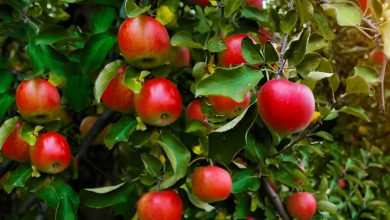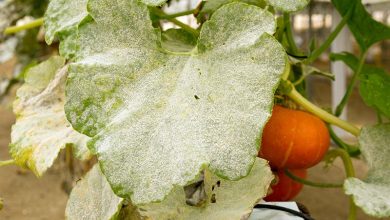Pepper Pests and Diseases: Complete Guide with Photos and Tips
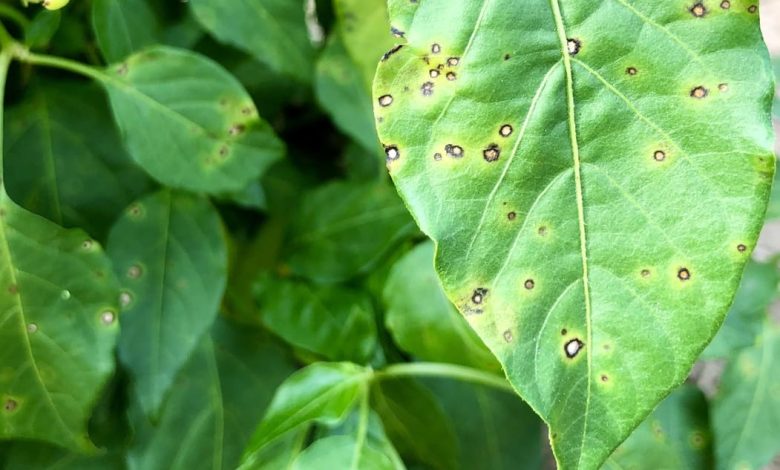
Hello again! As I have told you, we are going to make a compilation of the most common pests and diseases of garden crops. We already have the tomato, and now we are going to talk about its cousin (also from the nightshade family). Both crops, tomato and pepper, belong to the same family, so they share many of these pests and diseases. Today we will review the most common pepper pests and diseases.
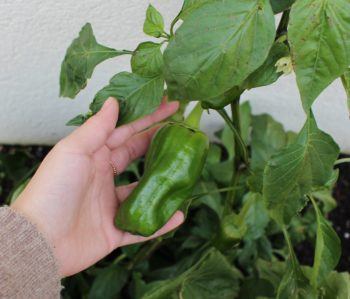
1. Pepper pests
As you know, a plague (caused by insects, rodents, snails…) is not the same as a disease. Diseases, on the other hand, are caused by microorganisms such as fungi, bacteria, nematodes… or by viruses. We are going to see first the pests and diseases of the pepper, and in the next section we will see other problems of the pepper crop such as the lack of nutrients.
1.1. Worms and caterpillars on bell pepper
We come across some considerable-sized perforations through which, sometimes, we can see the caterpillar gobble up our fruit. You can also see gnawing on leaves, flowers, fruits and tender shoots, usually with droppings and NO SLIME (it gives us the clue that it is not a snail or slug).
The most common species are: Heliotis sp., Helicoverpa spp., Spodoptera spp., Autographa gamma, etc.

If we talk about pepper caterpillars, we must not miss the Tuta Absoluta. The symptoms caused by this Lepidoptera are wide mines that leave the epidermis intact but remains of excrement can be seen inside. The shoots are moth-eaten and the fruits have holes and blackened internal areas.
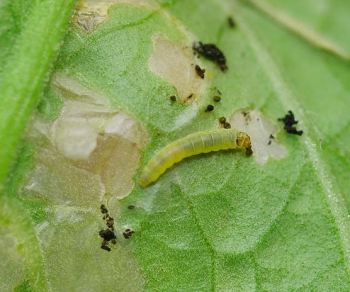
1.2. Aphids on pepper leaves
Aphids produce downward curling and wrinkling of leaves. In addition, you can see colonies of these small dark or greenish insects, especially in the tender shoots of the developing plant. Another clue is the presence of molasses (sugary and sticky substance) and ants around them defending them.
The most common species are: Myzus persicae, Macrosiphum euphorbiae, Aulacorthum solani…
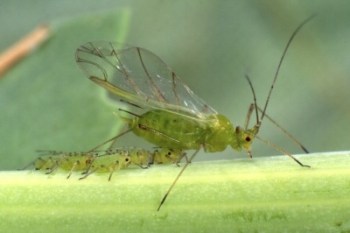
1.3. Whiteflies on bell pepper leaves
We can see some white midges (which are not actually flies) with a characteristic erratic flight when shaking the plant. Also, like aphids, they release honeydew. They are usually arranged on the underside of the leaves.
Main species: Trialeurodes vaporarium and Bermisia tabaci.
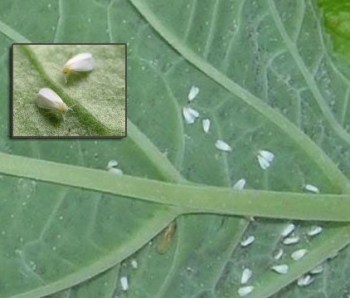
1.4. Spider webs on bell pepper
The red spider mite is a mite that leaves discolored leaves with small dots and silks. If it affects significantly, it can cause desiccation and defoliation of the plant.
The main species is Tetranychus urticae.
1.5. White spider (Polyphagotarsonemus latus)
This mite leaves the leaves convex, curved, darker and with an elongated appearance and protruding nerves.
1.6. Galleries in pepper leaves
The leafminer fly (Liriomiza spp.) makes clear and sinuous galleries in the leaves.
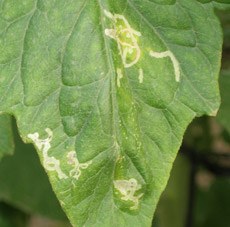
1.7. Bugs on bell pepper flowers
Flower thrips (Frankliniella occidentalis).Damaged plants have leaves with small irregular silver spots, which correspond to lesions on the underside.
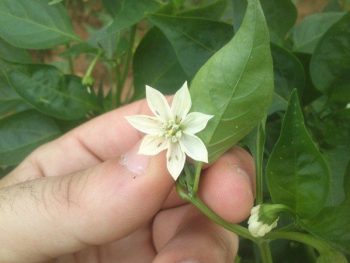
Other pests that can affect peppers but are less common:
1.8. Vasates (Aculops lycopersici)
The leaves of the plant dry out, taking on a pinkish color and the stem turns tan until they are both dry and reddish yellow because of this mite.
2. Pepper diseases
2.1. Yellow spots on bell pepper leaves
Oidiopsis (Leveillula taurica, Phytophtora capsici, Alternaria solana).Fungal disease in which we find yellowish spots on the upper part of the leaf that quickly become necrotic and a kind of whitish powder appears on the underside.
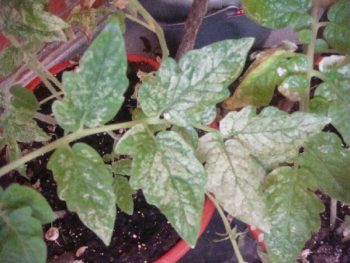
2.2. Sadness or dry pepper (Phytophtora capsici)
A sudden and irreversible wilting of the entire plant appears without defoliation, especially at the time of fruit development. In addition, necrosis can be observed in the neck (the lowest part of the stem that borders the substrate) and root rot. It can occur in isolated plants or by lines.
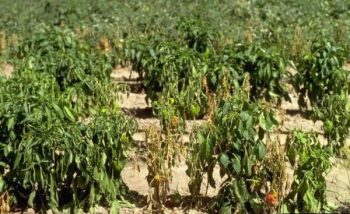
23. Neck and root rot
Usually due to Phytophthora spp. Pythium sp., Rhizoctonia solani, Sclerotinia sp. etc.Young plants wither, presenting strangulation and rotting on the neck.
2.4. Lumps on pepper roots: nematodes
Nematodes (Meloidogyne spp.).Nematode-infected plants exhibit weak growth, wilting, chlorosis, and deformed and galled roots (nodules). Distribution in stands (plants forming more or less circular areas) or following irrigation lines.
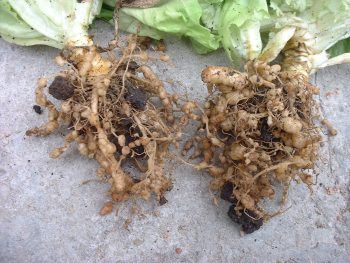
2.5. peppers with viruses
Mosaics in leaves, dwarfism, chlorotic rings (yellow), curling and curling of leaves, deformation of fruits with wavy spots or rings…
Symptoms are varied (although yellow leaves on peppers are often a common denominator), and there are also several types of orchard viruses that can affect peppers.
3. Differences between physiopathies and pepper pests and diseases
Physiopathies are problems other than pepper pests and diseases. They are caused by abiotic factors, that is, by stress caused because the environmental conditions are not adequate. They can be the result of deficiencies or excesses of nutrients, cold or high temperatures, drought or poor management of irrigation or salinity, among others.
3.1. End of rotten pepper
In the fruit of the pepper the spot is brown, more or less elongated or lateral in the lower half of the fruit
3.2. White spots on bell pepper
On the side of the fruits exposed to the sun, a depressed white area appears, leaving the tissue with a papery appearance and, if the fruit is still young, a scar forms later.
3.3. rolled bell pepper leaves
The plants curl up the leaflets of the leaves, taking the plant a coiled appearance.
References
- Healey M, Senior L, Brown P, Duff J (2017).Relative abundance and temporal distribution of adult Frankliniella occidentalis (Pergande) and Frankliniella schultzei (Trybom) on French bean, lettuce, tomato and zucchini crops in relation to crop age. Journal of Asia-Pacific Entomology, 20(3), 859-865.
- Rogers, D., Brier, H. (2010).Pest-damage relationships for Helicoverpa armigera (Hübner) (Lepidoptera: Noctuidae) on soybean (Glycine max) and dry bean (Phaseolus vulgaris) during pod-fill. Crop Protection, 29(1), 47-57.
- Abrol, D., Shankar, U. (2016). Chapter 20 – Integrated Pest Management. Editor(s): Surinder Kumar Gupta. Breeding Oilseed Crops for Sustainable Production, Academic Press. 523-549.
I hope it will help you to identify pepper pests and diseases. As I have promised you, little by little I will talk about each one of them so that you can face them and get a good harvest. See you soon!

![Photo of Spanish Jasmine Cuttings: [Time, Eradication, Planting and Fertilizer]](https://www.complete-gardening.com/wp-content/uploads/2022/08/spanish-jasmine-cuttings-time-eradication-planting-and-fertilizer-390x220.jpg)
![Photo of Bach Flowers: [Examples, Care, Characteristics and Meaning]](https://www.complete-gardening.com/wp-content/uploads/2022/08/bach-flowers-examples-care-characteristics-and-meaning-390x220.jpg)
